Abstract
The holistic green energy transition of non-interconnected islands faces several challenges if all the energy sectors are included, i.e., electricity, heating/cooling, and mobility. On the one hand, the penetration of renewable energy systems (RES) is limited due to design restrictions with respect to the peak demand. On the other hand, energy-intensive heating and mobility sectors pose significant challenges and may be difficult to electrify. The focus of this study is on implementing a hybrid Wind–PV system on the non-interconnected island of Anafi (Greece) that utilizes surplus renewable energy production for both building heating through heat pumps and hydrogen generation. This comprehensive study aims to achieve a holistic green transition by addressing all three main sectors—electricity, heating, and transportation. The produced hydrogen is utilized to address the energy needs of the mobility sector (H2 mobility), focusing primarily on public transportation vehicles (buses) and secondarily on private vehicles. The overall RES production was modeled to be 91,724 MWh with a RES penetration of 84.68%. More than 40% of the produced electricity from RES was in the form of excess electricity that could be utilized for hydrogen generation. The modeled generated hydrogen was simulated to be more than 40 kg H2/day, which could cover all four bus routes of the island and approximately 200 cars for moderate use, i.e., traveled distances of less than 25 km/day for each vehicle.
1. Introduction
Energy provision within an insular context comes with certain constraints and complexity; therefore, the required solutions for the green transition must be tailored. Contrary to an interconnected mainland grid, island energy systems face limited access to goods and markets, high transport costs, low-to-no economies of scale due to small size and power production or demand, great back-up needs, and higher dependency in maritime sector [1]. Approximately 20 million people live in autonomous, insular electrical grids of 15 GW capacity [2] and only in the Pacific ocean. Approximately 70% of the population of the island do not have access to electricity [3]. Countries such as the Philippines, Indonesia, and Greece that spread over archipelagos face high energy prices and an often limited security of energy supply. A study by Eras-Almeida and Egido-Aguilera (2019) reviewed ten non-interconnected insular mini grids across the world and identified several key factors affecting the implementation of renewable energy [4]. Factors such as the island’s size, remoteness, renewable energy potential, population, load profile and seasonality due to tourism, and availability of local technical expertise are among the most important. Insular renewable systems need to be oversized to cover the load, which leads to high shares of excess energy. This excessive production must be tapped as so to create alternative revenue streams for the projects and make the investments favorable. Gabderakhmanova and Marinelli (2022) have gathered pilot projects from all over Europe that try to couple renewable production with other sectors, mainly heating/cooling, transportation, and gas production [5]. Several studies have linked the excess PV energy production to electric ferries that are powered by lithium batteries. The replacement of the car fleet of an island with battery electric vehicles is always an attractive research field [6], although it can only have an impact in lowering CO2 emissions if there is high RES penetration in the energy mix first, as shown by Nuez et al., (2022) [7].
High RES penetration from PV and wind generators should be considered along with grid stability. Apart from their stochastic nature, since they are connected to the grid via power converters, they do not provide any inertial response to the system, as the conventional thermal generators do, and so disturb the grid frequency during imbalances of power, leading to an increase in the risk of blackouts [8]. Furthermore, generation scheduling under a high RES environment becomes problematic when the maximization of RES share production is the sole goal because it impacts the economic operation of the grid system. The need for flexible conventional generators (diesel or gas powered) which have lower minimum loads and higher generation costs is essential to cope with the increased ramping up and down requirement [9]. Increased RES penetration comes with higher initial investments and higher requirements for operating reserves, which, in the case of batteries, increase the cost drastically, at least with the current prices. As many studies have shown, the most cost-efficient renewables share is in the range of 40 to 60% [10], and in some studies as high as 75% [11]. Forecasted load growth until 2050 was considered in the work of Arévalo et al., (2022) for the Galapagos Islands, where a hybrid solution consisting of PV, wind turbines, battery storage systems, and diesel generators was modeled using EnergyPLAN software [12]. Thus, the optimal energy mix of a specific insular autonomous grid is a multifactor function of RES potential, load profile, available funds, grid safety requirements, and goal prioritization (e.g., clean production vs. LCOE optimization).
During the past few years, there has been an exponential increase in the number of published articles regarding renewable energy deployment in autonomous, islandic grids with most of which being case studies. Chaichan et al., (2022) studied a hybrid solution for Koh Samui island in Thailand, which included PV, wind turbine, fuel cell, and battery storage as the alternative to a diesel generator or mainland grid connection [13], while Qi et al., (2022) performed an economic analysis for a hybrid system on the island of Qingdao in China [14]. Different types of electrochemical batteries were studied by Babaei et al., (2022), namely, Li-Ion, Lead Acid, and Thin Plate Pure Lead for a stand-alone hybrid energy system in Pelee Island [15]. Berna-Escriche et al., (2022) examined the 100% coverage of the 2040 forecasted energy demand of the Canary Islands with PV, wind turbine, pumping storage, and battery storage, concluding that high amounts of excess energy are a necessary outcome of high RES penetration in stand-alone grids [16], an outcome shown also by Dimou and Vakalis, (2022) [17]. The 100% renewable generation is also investigated for the island of Sao Vicente, in which they analyzed three scenarios, namely, Business As Usual, Optimal, and Green, and also considered three load growth levels for each scenario in order to reduce uncertainty [18]. Carere et al., (2022) studied the 100% renewable solution for the island of Sardinia and stressed the very high curtailment percentages under all potential set-ups [19]. Meza et al., (2019) are investigating the 100% green transition of a small Nicaraguan island and propose, apart from PV and wind turbines, a pumped hydro storage to provide a primary load and a biogas plant for serving the peak loads [20].
Kavadias et al., (2018) investigated the introduction of hydrogen production as a means to minimize the large curtailments of PV and wind energy production in an insular grid of nine Greek islands [21]. In a small Italian island, Groppi et al., (2018) suggested that annual hydrogen produced from excess PV energy production can cover the local public transportation needs [22]. Herenčić et al., (2021) compared different set-ups of PV and wind power generation coupled with BESS and hydrogen storage for two different islands in Europe and suggested that hydrogen provides great flexibility in the grid design [23]. Fukaume et al., (2022) presented the case of a PV-Wind hybrid solution coupled with an electrolyzer, fuel cell, and an electric capacitor to accommodate the short-term power fluctuations for a small island in Japan [24]. Greening of the maritime sector has also been considered at a domestic ferry-scale level, where its prioritization over the heating sector of an island is stressed due to the much higher CO2 emissions [25]. Zhang et al., (2022) have made a techno-economic evaluation of various solutions to replace the conventional thermal generators of a small island and came up with the conclusion that the optimal solution both in terms of Net Percent Cost and Levelized Cost of Energy is the combination of PV and wind generators with lithium battery storage and hydrogen storage [26]. The Canary Islands were also studied and the authors calculated very promising amounts of H2 produced and at competitive prices in a 100% RES-powered energy system [27]. Żołądek et al., (2022) investigated the case of two touristic resorts from an economic viability perspective and the introduction of a hybrid system consisting of a PV, WTG, wood chip gasifier, Li-ion batteries, and a hydrogen component, with not-so-promising findings [28]. In addition, the introduction of a hydrogen production component in the residential sector of islands is proposed by Nastasi et al., (2021) with some encouraging results [29]. The introduction of an H2 component consisting of a water electrolyzer, an H2 tank, and a fuel cell in a renewable energy system significantly reduces the required size of the batteries component, as was shown by Marocco et al., (2022) in their work on the Froan Islands [30]. Additionally, the required RES-rated power is almost halved with the introduction of H2; thus, the overall cost of the system becomes much more favorable and drops the LCOE at around EUR 0.41/kWh. Electrochemical batteries are used in the short term to cope with the intermittent production of RES, while H2 is involved in the long term and has a more seasonal exploitation [31].
Recently, the literature has tried to answer the question of covering the demand by using only the local resources of the non-interconnected islands via the concept of multi-energy microgrids (MEMG). Renewable energy production is stochastic in its nature; thus, storage in hydrogen form has obvious benefits, although difficult to model. The modeling of the uncertainty of energy management under this context is approached with stochastic optimization [32], robust optimization [33], and chance-constrained optimization [34]. Taking this a bit further, Khaligh et al., (2023) [35] proposed a stochastic p-robust approach in which they take advantage of both the stochastic and robust optimization methods.
Therefore, the main question that this study focuses on is the ability of a non-interconnected island to sufficiently cover the holistic energy demands (electricity, heating/cooling, transportation) with a RES system and green hydrogen production. In respect of the scope, this paper models the operation of a hybrid Wind–PV system for the total green energy transition of a non-interconnected island with the focus of the study being the simultaneous utilization of the excess RES energy for hydrogen production. This total energy transition includes—except the electricity sector—the demand for heating/cooling and the energy requirements for transportation on the island. Subsequently, the study utilizes real mobility data and presents a case study for the use of hydrogen in the mobility sector. In particular, the hydrogen demand for the green mobility transition of public transportation is assessed and the remaining available hydrogen for use in private vehicles is considered. This study suggests a technological alternative to e-mobility studies, such as the Astypalaia case, but without neglecting the positive role of e-mobility.
2. Materials and Methods
Anafi was selected for the study due to its small size, low population that remains fairly consistent throughout the year, and lack of connection to the mainland network. The island was also chosen for its high wind potential. Anafi is among the Non-Interconnected Islands (NII) and falls under the category of ‘small’ NIIs, with an annual peak demand of no more than 10 MW. Currently, Anafi is not connected to the mainland electricity grid, but there are plans to connect it via submarine cables between the Santorini-Anafi islands in the 4th Phase interconnection of the Cyclades [36]. The local power station on the island, comprising five internal combustion engines with a total nominal power of 1.1 MW, meets the energy needs of its inhabitants. According to the Production Data Sheets of HEDNO [37] for NIIs, the annual peak demand in the last 5 years ranged from 0.59 MW in 2017 to 0.55 MW in 2021. As for the required energy of the island’s thermal units, it varied from 77.93 MWh in April 2021 to a maximum price of 278.03 MWh in August 2021. These data are based on hourly electricity demand as published by the Production Data Sheets of the Hellenic Electricity Distribution Network Operator (HEDNO) for the NIIs. In addition, the thermal demand of the island has been calculated by taking into account the Heating Degree Days (NASA weather database) [38] and the annual thermal energy demand per capita for Greece, as presented in the study by Kotsila and Polychronidou (2021) [39]. The values of total energy and thermal demand for Anafi are presented in the latter part of this study.
Anafi is a small triangular-shaped island belonging to the Cyclades complex of the Aegean Sea, located east of Thira and 155 nautical miles from Piraeus. It consists of three settlements: Anafi, Kleisidi, and Agios Nikolaos or Gialos, with a total population of 257 according to the 2021 census. The island covers an area of approximately 39 km2 and has a mountainous terrain, with its highest peak at Vigla mountain measuring 579 m. The island has a lengthy coastline spanning 32.4 km with no significant bays, and there are the small uninhabited islets Ftena, Pachia, and Makria in the south. The study retrieved solar radiation data from the software RETScreen and wind potential data from the Geographical Map of RAE, with Figure 1 showing the solar radiation and Figure 2 displaying the average annual wind speed on the island [40].
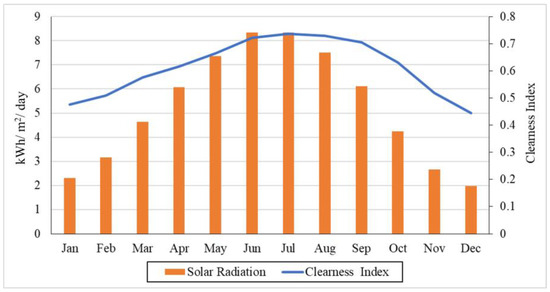
Figure 1.
Daily solar radiation and clearness index for the island of Anafi.
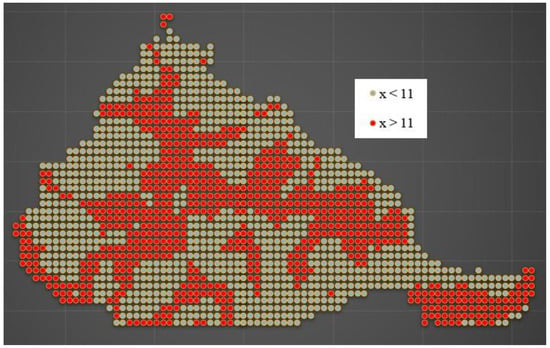
Figure 2.
The areas with lower and higher average annual wind speeds for Anafi.
The proposed design is presented in Figure 3 and consists of a wind turbine, a PV park, and a series of electrolyzers. The model selected for the wind turbine is an Enercon-48–76 m with a nominal power output of 800 kW. The turbine has a hub height of 76 m, a rotor diameter of 48 m, and a swept area of 1809.56 m2. The 240 kWp PV park consists of Canadian Solar PV CS5A-180MX panels with 16% efficiency, and individual panels of 180 Watt and an area of 1.28 m2.
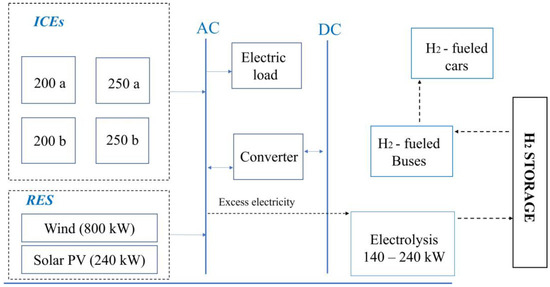
Figure 3.
Schematic of the model components—Anafi green island.
The heat demand is covered by means of generic heat pumps with a COP equal to 3. Two internal combustion engines (ICE) are considered to be available and to operate when there is a RES production deficit in respect to the demand. The considered electrolyzers along with their operating characteristics are presented in Table 1. It has to be stated that the system considers storage of hydrogen throughout the year in order to cover the demand during the peak months.

Table 1.
Characteristics of commercial electrolyzers.
This paper employs a software tool developed by the United States National Renewable Energy Laboratory (NREL) called HOMER PRO, which is specifically designed for modeling microgrids and stand-alone systems that incorporate various renewable energy technologies such as photovoltaics, wind turbines, conventional generators, heat pumps, batteries, and hydrogen production. HOMER PRO simulates every possible technological combination and optimizes each system according to the lowest net present cost that can serve the designated load, typically for one year but with the option to run the system for multiple years. The software provides comparative reports on performance, financials, and design parameters and calculates the system’s optimum sizing [41]. In this work, we have selected the system with the highest renewables penetration which also has the lowest CO2 emissions.
The power of the PV park is calculated with Equation (1):
- YPV: power output of the PV array at standard testing conditions (STCs);
- FPV: PV derating factor;
- It: solar radiation incident on the PV at the current time step;
- ISTC: solar radiation incident on the PV under STCs;
- a: temperature coefficient of power;
- Tc: PV cell temperature at the current time step;
- TSTC: PV cell temperature under STCs.
The wind turbine output is calculated with Equations (2) and (3):
- Uanem: wind speed at anemometer height;
- Zhub: height of the wind turbine;
- Zanem: height of the anemometer;
- Z0: surface roughness length.
According to the turbine’s power curve, the wind turbine power output is calculated at standard air density and adjusted for the actual air density:
- ρ: actual air density;
- ρ0: air density at standard air density;
- PSTP: wind power output at standard air density.
For the calculation of the wind fluctuation, the software utilizes the Weibull distribution with the Weibull K factor set to 2 as default. Sensitivity analysis has been included by assuming a potential fluctuation of 20% for wind and solar power.
Finally, this study utilizes real data from the exiting and operating bus routes on the island. Four separate bus routes operate daily on the island of Anafi and the details are presented in Table 2. With respect to the consumption of the Buses, a value of 0.1 kg/km is considered, in accordance with the study by Pederzoli et al., (2022) [42]. The study primarily focuses on covering public transportation routes with hydrogen. In the case of excess hydrogen, the study assesses the hydrogen availability for private vehicles. The study identified three exiting commercial models with their corresponding nominal consumption characteristics: Hyundai NEXO (0.84 kg/100 km), Toyota MIRAI II (0.76 kg/100 km), and Hyundai ix35 (1 kg/100 km) [43]. Moreover, three scenarios were considered, with daily mileage per vehicle being 15, 25, and 50 km.

Table 2.
All the bus routes that operate on the island of Anafi.
This study introduces the concept of combining the green energy transition of a non-interconnected island with H2 mobility and declares clearly that the lack of economic analysis is a limitation of the study that will be addressed in the future. It should be denoted that this study focuses on the increased valorization of the excess energy from RES, which is significant in all cases of Greek islands. The option of hydrogen is assessed in order to investigate the degree that hydrogen can meet the holistic energy demands of the island, including the thermal demand and the energy demand for mobility. The proposed RES design follows a typical Wind–PV hybrid approach that had the scope to reach RES penetration of 80–85% in a similar manner to the proposed cases of Ai Stratis and with the framework of the Greco islands. The lack of optimization of the design is a limitation of the study and will be addressed in future work. The reasons that the financial aspect has not been studied are the fluctuating prices of fossil fuels, the changing costs for hydrogen production along with the still immature applications around the world, although estimates are that the installation cost will fall by 40% until the end of the decade and an additional 20% by the end of 2040 [44], and the not stable situation in respect to the financing schemes for the energy upgrade of buildings. Another limitation is that no alternative renewable energy system components were considered as the current study is a first approach to the decarbonization potential of the island at hand and thus such consideration shall be made at the next stage. Finally, the long-term demographic change in the small island of Anafi was not addressed in the current paper due to uncertainty. Although the population trend has been declining in the past decades, it can reverse if the tourism industry develops.
3. Results
Figure 4 presents the electricity demand per month along with the combined electricity and thermal demand per month, along with their standard deviations. As seen in the figure, the two values are identical for the summer months since these are the months with zero heating degree days. In addition, a seasonal effect is observed on the demand for energy, and this can be attributed primarily to the touristic effect and the existing demand for cooling via A/C units. An additional parameter that needs to be highlighted is the higher deviation of the values that are attributed to the heat demand in the winter months relative to the lower deviation values for the electricity demand. In the country, higher standard deviations for electricity demand are observed during the summer months, which can be attributed to the utilization of electricity for cooling but also to the higher peak demand values. Tampakis et al., (2017) showed that residents in Greek island communities are positively oriented towards renewables. Another factor is the seasonal load demand, especially in tourist destinations with peak demand during vacation months and with unpredictable patterns [45]. For comparison, the total electricity production from RES is also presented in the Figure and is analyzed further in Figure 5.
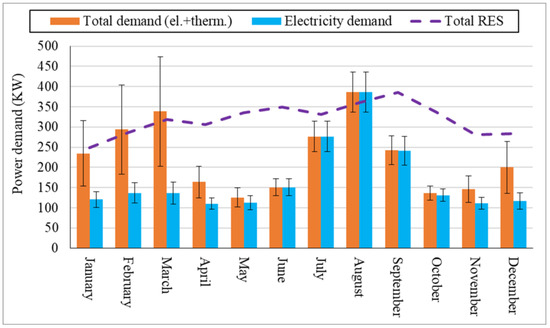
Figure 4.
The average monthly demand for electrical and thermal power for Anafi along with the total power production of RES.
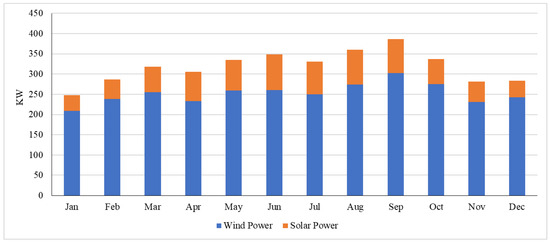
Figure 5.
Simulated produced wind and PV power per month with the suggested hybrid system.
Figure 5 presents the average power from RES throughout the year. As expected, the PV panels deliver more electricity during the summer months and this aspect assists the system to account for the increased electricity demand during the summer months. On the other hand, wind turbines on average have a power output of more than 200 kW for all months and peak in late spring and autumn. The wind turbine produces the majority of the electricity, but the PV panels assist significantly in covering the demand during the day.
Overall, the hybrid Wind–PV system with the addition of heat pumps has a RES penetration of 84.68%, which is close to the target value of 85% for green islands, such as in the case of Ag. Efstratios. The detailed values of the system operation are presented in Table 3. Overall, the total energy demand for electricity and heat was 64,402 MWh and the renewable energy systems produced 91,724 MWh, with 40.55% of this total value being excess electricity that can be utilized for hydrogen production. As mentioned previously, the RES penetration was 84.68%, and in order to cover the demand a combined operation of 100 h was necessary from the two internal combustion engines.

Table 3.
Operation characteristics of the suggested hybrid system.
Figure 6 shows the excess electricity produced by RES for every month of the year along with the range of possible values when a fluctuation of wind power and solar power is considered. Peak months for excess electricity are the spring and autumn months and correspond with the months that wind power is higher, and the demand is at a lower level than in the summer months. At the same time, Figure 6 presents the total electricity shortage at peak demand on a monthly basis. As seen in the figure, the high thermal demand of the winter months along with the high electricity demand during late July and August are the main reasons that RES do not have 100% penetration but a little bit below 85%, as seen in Table 3. On the one hand, excess electricity should be valorized. On the other hand, electricity shortages should be covered in order to avoid blackouts.
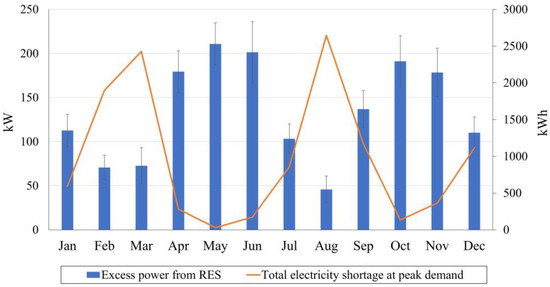
Figure 6.
Simulated average excess RES power and total electricity shortage at peak demand from the operation of the suggested hybrid system.
This excess electricity, as presented in Figure 6, will be utilized for the production of green hydrogen by means of the selected electrolyzer, which in this case is the Norsk30, as described by Dimou et al., (2021) [46]. In particular, two electrolyzers will be operating for the peak months and one during the non-peak months. The operation of the proposed electrolyzer, i.e., Norsk30, along with all the other examined electrolyzers is presented in Figure 7. As seen in the figure, Norsk30 performs significantly better in comparison to the other examined models and this can be attributed to the lower energy demand per kg of hydrogen production and to the relatively good size of the electrolyzer for this specific case.
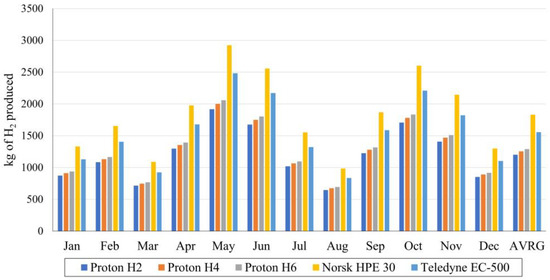
Figure 7.
Monthly and average H2 production from all analyzed electrolyzers.
The operation of the electrolyzer and, subsequently, the production of hydrogen is presented in Figure 8 for every month. In addition, the monthly consumption of hydrogen for the operation of the buses is being considered, and as mentioned before, it is equal to 18 kg/day. The remaining hydrogen from each month is added and the net available hydrogen for utilization in vehicles is calculated.
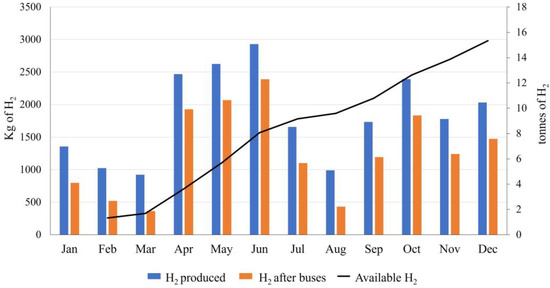
Figure 8.
Simulated produced hydrogen along with the net quantities after fueling the buses.
A total amount of 15,331.25 kg of hydrogen can be available for a whole calendar year, which on average corresponds to 41.96 kg per day. In this analysis, we consider three scenarios that correspond to different distances driven per day, i.e., 15, 25, and 50 km, by three models that are available commercially. The analysis, as presented in Figure 9, showed that for moderate distances, i.e., <25 km/day, the existing design can support more than 200 H2 cars. Given the size and the population of the island, this solution can be sufficient for the majority of transportation needs on the island. The heating and mobility needs of two northern, grid-interconnected European islands via hydrogen storage are assessed by Kartalidis et al. (2021). In their work, it is shown that there are additional benefits in hydrogen storage in the form of minimization of energy imports and RES curtailment [47].
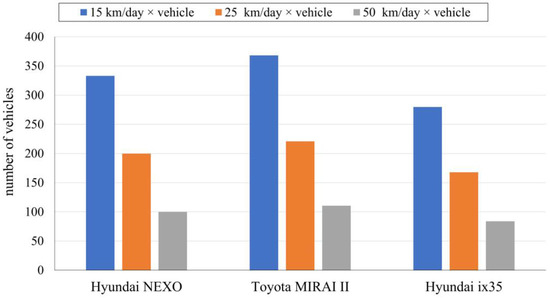
Figure 9.
Number of vehicles that can be fueled with excess hydrogen on Anafi in relation to average daily mileage.
4. Discussion
In a more holistic approach, Cabrera et al. (2018) have researched the Grand Canaria island case study where they propose a cross-sectoral approach and identify 17 scenarios of various smart energy strategies in power production, heating/cooling, transportation, and desalination [48]. Skroufouta and Baltas (2021) suggest the integration of a reverse osmosis desalination plant in a Greek island’s energy mix [49]. There have been some studies investigating alternative pathways to greening autonomous grids where syngas [50] or biogas [51] utilization is investigated under an insular environment. As an alternative, the use of green ammonia as energy storage combined with wind turbines has been examined [52]. The more batteries or H2 tank capacity is introduced in the storage component of an autonomous grid system, the less the RES curtailment will be [53]. Thus, the optimum sizing is primarily a function of cost, when, according to a recent study [54], H2 applications are still more expensive than traditional fossil alternatives.
In terms of environmental impact assessment of the hydrogen storage solutions, Gandiglio et al., (2022) provided a life cycle analysis for an insular system of Norway where they compared conventional thermal generation, subsea cable connection to the mainland grid, and a RES system coupled with H2 storage component [55]. The authors have found that hydrogen is better than fossil generation but slightly worse than the interconnection alternative, from an LCA point of view, although this is highly dependent on the energy mix of the main grid system. Bionaz et al., (2022) conducted an LCA analysis of a hybrid, hydrogen system in an isolated, non-interconnected community and found it superior to its fossil-powered alternative across all categories except those of water use and mineral and metal resources [56].
Approximately the same values for how LCOE and H2 impact battery size decrease were obtained by Shahid et al., (2022), who investigated 21 French autonomous islands both in the Atlantic and in the Mediterranean [57]. On the other hand, Monforti Ferrario et al., (2021) modeled the impacts of batteries and H2 storage in a residential load and found that although hybridization of the storage component is always better in regard to energy security and efficiency, it is not so in terms of economics [58]. Hydrogen advantages are shown in the long-term storage horizons, not for short-term needs. It is usually mentioned in the literature that the main barriers to the required development of renewables in islands are lack of funds, social acceptance, and scarcity of local technical expertise [59].
Overall, the main question that needs to be addressed is if the coupling of a hybrid Wind–PV system with hydrogen production can sufficiently cover the total energy demand (electricity, heating/cooling, and transportation) of a non-interconnected island. As shown in the Results section, hydrogen can successfully power all the existing public transportation on the island and more than 200 private vehicles. The suggested system does not cover 100% of the energy demands of the island with RES but provides a RES penetration of over 85% for the sectors of electricity and heating/cooling, and if transportation is included, this value is significantly higher. The exciting parameter that needs to be denoted is that H2 mobility can be a reliable alternative to e-mobility, without the drawback of increasing the electricity peak demand, in contrast to increased power demand during the charging of the e-vehicles. An aspect that needs to be assessed for the case of non-interconnected islands is not only the total energy demand but also the successful management of the peak energy demand. The promotion of electrification can be a very viable pathway for the mainland/central grid, but for isolated grids, electrification should be designed properly due to the additional demand from the heat pumps, the e-vehicles, and the scheduled cold ironing (e-ports) installations. Nonetheless, the utilization of hydrogen has to overcome several uncertainties before becoming an established technology. One significant aspect of H2 introduction in energy production systems is that of storage and distribution. Various storage methods have been proposed, namely, compression in tanks up to 1000 bar, liquification, which requires temperatures at −253 °C, liquid-organic carriers that also need high pressure and temperature with ammonia being the most promising candidate for the task, and finally, the solid-state method through sorption by which H2 molecules are accumulated on the surface of solid materials [60]. All the above are being heavily investigated and come with significant challenges and advantages depending on the application. In the case of small, non-interconnected islands, such as Anafi, a single point of storage can also cover the distribution needs.
5. Conclusions
This study designed a hybrid Wind–PV system and combined it with heat pumps and electrolysis in order to use the hydrogen for the total green energy transition—including transportation—of a non-interconnected island that in this case was Anafi (Greece). An 800 KW wind turbine and a 240 KWp PV park were coupled with two Norsk30 electrolyzers for the production of 91,724 MWh of RES electricity with 84.68% penetration and the use of the excess electricity for the production of 15.3 t of hydrogen annually. This can cover the demand for more than 200 private vehicles with moderate use and the fuel demand of the public transportation operating on the island. Further research should analyze the financial feasibility of the required renewable energy systems and hydrogen infrastructure, along with alternative component capacity and size wise. In addition, the inclusion of the maritime transportation needs of the island is a potential research field. Overall, hydrogen can be a good option for the energy storage of excess RES, but the technological maturity and the cost competitiveness of hydrogen technologies still have the capacity for improvement. This case study can be a valuable addition to the discussion of what is the better pathway towards the green transition of non-interconnected small islands and how hydrogen may contribute to that, while considering also the transportation needs.
Author Contributions
Conceptualization, A.D. and S.V.; methodology, A.D. and S.V.; validation, A.D., K.M. and S.V.; formal analysis, A.D. and S.V.; investigation, A.D. and S.V.; resources, K.M. and S.V.; data curation, K.M.; writing—original draft preparation, A.D.; writing—review and editing, K.M. and S.V.; visualization, S.V.; supervision, K.M. and S.V.; project administration, S.V.; funding acquisition, S.V. All authors have read and agreed to the published version of the manuscript.
Funding
The research presented in this paper is partly financed by the European Union H2020 REACT project, Grant Agreement No.: 824395.
Data Availability Statement
All the data that were used for this research are publicly available and the sources have been provided in the reference list.
Conflicts of Interest
The authors declare no conflict of interest.
References
- Cross, S.; Padfield, D.; Ant-Wuorinen, R.; Phillip King, P.; Syri, S. Benchmarking island power systems: Results, challenges, and solutions for long term sustainability. Renew. Sustain. Energy Rev. 2017, 80, 1269–1291. [Google Scholar] [CrossRef]
- Blechinger, P.; Cader, C.; Bertheau, P.; Huyskens, H.; Seguin, R.; Breyer, C. Global analysis of the techno-economic potential of renewable energy hybrid systems on small islands. Energy Policy 2016, 98, 674–687. [Google Scholar] [CrossRef]
- Dornan, M. Access to electricity in Small Island Developing States of the Pacific: Issues and challenges. Renew. Sustain. Energy Rev. 2014, 31, 726–735. [Google Scholar] [CrossRef]
- Eras-Almeida, A.A.; Egido-Aguilera, M.A. Hybrid renewable mini-grids on non-interconnected small islands: Review of case studies. Renew. Sustain. Energy Rev. 2019, 116, 109417. [Google Scholar] [CrossRef]
- Gabderakhmanova, T.; Marinelli, M. Multi-Energy System Demonstration Pilots on Geographical Islands: An Overview across Europe. Energies 2022, 15, 3908. [Google Scholar] [CrossRef]
- Raveendran, V.; Alvarez-Bel, C.; Nair, M.G. Assessing the ancillary service potential of electric vehicles to support renewable energy integration in touristic islands: A case study from Balearic island of Menorca. Renew. Energy 2020, 161, 495–509. [Google Scholar] [CrossRef]
- Nuez, I.; Ruiz-García, A.; Osorio, J. A comparative evaluation of CO2 emissions between internal combustion and electric vehicles in small isolated electrical power systems—Case study of the Canary Islands. J. Clean. Prod. 2022, 369, 133252. [Google Scholar] [CrossRef]
- Curto, D.; Favuzza, S.; Franzitta, V.; Guercio, A.; Navia, M.A.N.; Telaretti, E.; Zizzo, G. Grid Stability Improvement Using Synthetic Inertia by Battery Energy Storage Systems in Small Islands. Energy 2022, 254, 124456. [Google Scholar] [CrossRef]
- Psarros, G.N.; Papathanassiou, S.A. A unit commitment method for isolated power systems employing dual minimum loading levels to enhance flexibility. Electr. Power Syst. Res. 2019, 177, 106007. [Google Scholar] [CrossRef]
- Uwineza, L.; Kim, H.-G.; Kleissl, J.; Kim, C.K. Technical Control and Optimal Dispatch Strategy for a Hybrid Energy System. Energies 2022, 15, 2744. [Google Scholar] [CrossRef]
- Barbaro, M.; Castro, R. Design optimisation for a hybrid renewable microgrid: Application to the case of Faial island, Azores archipelago. Renew. Energy 2020, 151, 434–445. [Google Scholar] [CrossRef]
- Arévalo, P.; Cano, A.; Jurado, F. Mitigation of carbon footprint with 100% renewable energy system by 2050: The case of Galapagos islands. Energy 2022, 245, 123247. [Google Scholar] [CrossRef]
- Chaichan, W.; Waewsak, J.; Nikhom, R.; Kongruang, C.; Chiwamongkhonkarn, S.; Gagnon, Y. Optimization of stand-alone and grid-connected hybrid solar/wind/fuel cell power generation for green islands: Application to Koh Samui, southern Thailand. Energy Rep. 2022, 8, 480–493. [Google Scholar] [CrossRef]
- Qi, X.; Wang, J.; Królczyk, G.; Gardoni, P.; Li, Z. Sustainability analysis of a hybrid renewable power system with battery storage for islands application. J. Energy Storage 2022, 50, 104682. [Google Scholar] [CrossRef]
- Babaei, R.; Ting, D.S.K.; Carriveau, R. Feasibility and optimal sizing analysis of stand-alone hybrid energy systems coupled with various battery technologies: A case study of Pelee Island. Energy Rep. 2022, 8, 4747–4762. [Google Scholar] [CrossRef]
- Berna-Escriche, C.; Vargas-Salgado, C.; Alfonso-Solar, D.; Escrivá-Castells, A. Can a fully renewable system with storage cost-effectively cover the total demand of a big scale standalone grid? Analysis of three scenarios applied to the Grand Canary Island, Spain by 2040. J. Energy Storage 2022, 52, 104774. [Google Scholar] [CrossRef]
- Dimou, A.; Vakalis, S. Technoeconomic analysis of green energy transitions in isolated grids: The case of Ai Stratis—Green Island. Renew. Energy 2022, 195, 66–75. [Google Scholar] [CrossRef]
- Pombo, D.V.; Martinez-Rico, J.; Marczinkowski, H.M. Towards 100% renewable islands in 2040 via generation expansion planning: The case of São Vicente, Cape Verde. Appl. Energy 2022, 315, 118869. [Google Scholar] [CrossRef]
- Carere, F.; Gatta, F.M.; Geri, A.; Lauria, S.; Maccioni, M.; Nati, L. Sardinia as a 100% renewable power system: A frequency stability study. Sustain. Energy Grids Netw. 2022, 32, 100899. [Google Scholar] [CrossRef]
- Meza, C.G.; Rodríguez, C.Z.; D’Aquino, C.A.; Amado, N.B.; Rodrigues, A.; Sauer, I.L. Toward a 100% renewable island: A case study of Ometepe’s energy mix. Renew. Energy 2018, 132, 628–648. [Google Scholar] [CrossRef]
- Kavadias, K.A.; Apostolou, D.; Kaldellis, J.K. Modelling and optimisation of a hydrogen-based energy storage system in an autonomous electrical network. Appl. Energy 2018, 227, 574–586. [Google Scholar] [CrossRef]
- Groppi, D.; Garcia, D.A.; Basso, G.L.; Cumo, F.; De Santoli, L. Analysing economic and environmental sustainability related to the use of battery and hydrogen energy storages for increasing the energy independence of small islands. Energy Convers. Manag. 2018, 177, 64–76. [Google Scholar] [CrossRef]
- Herenčić, L.; Melnjak, M.; Capuder, T.; Andročec, I.; Rajšl, I. Techno-economic and environmental assessment of energy vectors in decarbonization of energy islands. Energy Convers. Manag. 2021, 236, 114064. [Google Scholar] [CrossRef]
- Fukaume, S.; Nagasaki, Y.; Tsuda, M. Stable power supply of an independent power source for a remote island using a Hybrid Energy Storage System composed of electric and hydrogen energy storage systems. Int. J. Hydrog. Energy 2022, 47, 13887–13899. [Google Scholar] [CrossRef]
- Groppi, D.; Nastasi, B.; Prina, M.G. The EPLANoptMAC model to plan the decarbonisation of the maritime transport sector of a small island. Energy 2022, 254, 124342. [Google Scholar] [CrossRef]
- Zhang, X.; Wei, Q.S.; Oh, B.S. Cost analysis of off-grid renewable hybrid power generation system on Ui Island, South Korea. Int. J. Hydrog. Energy 2022, 47, 13199–13212. [Google Scholar] [CrossRef]
- Berna-Escriche, C.; Vargas-Salgado, C.; Alfonso-Solar, D.; Escrivá-Castells, A. Hydrogen Production from Surplus Electricity Generated by an Autonomous Renewable System: Scenario 2040 on Grand Canary Island, Spain. Sustainability 2022, 14, 11884. [Google Scholar] [CrossRef]
- Żołądek, M.; Kafetzis, A.; Figaj, R.; Panopoulos, K. Energy-Economic Assessment of Islanded Microgrid with Wind Turbine, Photovoltaic Field, Wood Gasifier, Battery, and Hydrogen Energy Storage. Sustainability 2022, 14, 12470. [Google Scholar] [CrossRef]
- Nastasi, B.; Mazzoni, S.; Groppi, D.; Romagnoli, A.; Garcia, D.A. Optimized integration of Hydrogen technologies in Island energy systems. Renew. Energy 2021, 174, 850–864. [Google Scholar] [CrossRef]
- Marocco, P.; Ferrero, D.; Lanzini, A.; Santarelli, M. The role of hydrogen in the optimal design of off-grid hybrid renewable energy systems. J. Energy Storage 2022, 46, 103893. [Google Scholar] [CrossRef]
- Marocco, P.; Ferrero, D.; Lanzini, A.; Santarelli, M. Optimal design of stand-alone solutions based on RES + hydrogen storage feeding off-grid communities. Energy Convers. Manag. 2021, 238, 114147. [Google Scholar] [CrossRef]
- Zandrazavi, S.F.; Guzman, C.P.; Pozos, A.T.; Quiros-Tortos, J.; Franco, J.F. Stochastic multi-objective optimal energy management of grid-connected unbalanced microgrids with renewable energy generation and plug-in electric vehicles. Energy 2021, 241, 122884. [Google Scholar] [CrossRef]
- Huo, D.; Gu, C.; Ma, K.; Wei, W.; Xiang, Y.; Le Blond, S. Chance-Constrained Optimization for Multienergy Hub Systems in a Smart City. IEEE Trans. Ind. Electron. 2018, 66, 1402–1412. [Google Scholar] [CrossRef]
- AkbaiZadeh, M.; Niknam, T.; Kavousi-Fard, A. Adaptive robust optimization for the energy management of the grid-connected energy hubs based on hybrid meta-heuristic algorithm. Energy 2021, 235, 121171. [Google Scholar] [CrossRef]
- Khaligh, V.; Ghezelbash, A.; Mazidi, M.; Liu, J.; Ryu, J.-H. P-robust energy management of a multi-energy microgrid enabled with energy conversions under various uncertainties. Energy 2023, 271, 127084. [Google Scholar] [CrossRef]
- ESDEK. National Energy and Climate Plans. 2019. Available online: https://ec.europa.eu/energy/sites/default/files/documents/el_final_necp_main_el.pdf (accessed on 6 November 2021).
- HEDNO. Report: Network Development Plan 2019–2023. Available online: https://deddie.gr/Documents2/DIAVOULEYSEIS%202018/DD%20ANAPTIXI%20DIKTYOY/%CE%A3%CE%91%CE%94%202019-2023.pdf (accessed on 20 December 2021).
- RETScreen. Available online: https://www.nrcan.gc.ca/maps-tools-and-publications/tools/modelling-tools/retscreen/7465 (accessed on 1 March 2023).
- Kotsila, D.; Polychronidou, P. Determinants of household electricity consumption in Greece: A statistical analysis. J. Innov. Entrep. 2021, 10, 19. [Google Scholar] [CrossRef]
- RAE GEO Portal. Available online: https://geo.rae.gr/?tab=viewport_maptab (accessed on 2 March 2023).
- Homer Energy Support. Available online: https://homerenergy.my.site.com/supportcenter/s/ (accessed on 2 February 2023).
- Pederzoli, D.W.; Carnevali, C.; Genova, R.; Mazzucchelli, M.; Del Borghi, A.; Gallo, M.; Moreschi, L. Life cycle assessment of hydrogen-powered city buses in the High V.LO-City project: Integrating vehicle operation and refuelling infrastructure. SN Appl. Sci. 2022, 4, 57. [Google Scholar] [CrossRef]
- H2 MOBILITY Deutschland GmbH & Co. KG, Hydrogen Vehicles—All Models at a Glance. Available online: https://h2.live/en/fcev/ (accessed on 7 March 2023).
- IRENA. Hydrogen: A Renewable Energy Perspective, Irena. 2019. Available online: https://irena.org/publications/2019/Sep/Hydrogen-A-renewable-energy-perspective (accessed on 23 January 2023).
- Tampakis, S.; Arabatzis, G.; Tsantopoulos, G.; Rerras, I. Citizens’ views on electricity use, savings and production from renewable energy sources: A case study from a Greek island. Renew. Sustain. Energy Rev. 2017, 79, 39–49. [Google Scholar] [CrossRef]
- Dimou, A.; Vakalis, S. Assessing the Utilization of Fuels Cells for the Valorization of Produced Excess Energy in Isolated Grids—The Green Transition of Agios Efstratios. In Proceedings of the CEST 2021—17th International Conference on Environmental Science and Technology, Athens, Greece, 1–4 September 2021. [Google Scholar]
- Kartalidis, A.; Atsonios, K.; Nikolopoulos, N. Enhancing the self-resilience of high-renewable energy sources, interconnected islanding areas through innovative energy production, storage, and management technologies: Grid simulations and energy assessment. Int. J. Energy Res. 2021, 45, 13591–13615. [Google Scholar] [CrossRef]
- Cabrera, P.; Lund, H.; Carta, J.A. Carta, Smart renewable energy penetration strategies on islands: The case of Gran Canaria. Energy 2018, 162, 421–443. [Google Scholar] [CrossRef]
- Skroufouta, S.; Baltas, E. Investigation of hybrid renewable energy system (HRES) for covering energy and water needs on the Island of Karpathos in Aegean Sea. Renew. Energy 2021, 173, 141–150. [Google Scholar] [CrossRef]
- Vargas-Salgado, C.; Águila-León, J.; Alfonso-Solar, D.; Malmquist, A. Simulations and experimental study to compare the behavior of a genset running on gasoline or syngas for small scale power generation. Energy 2022, 244, 122633. [Google Scholar] [CrossRef]
- Masala, F.; Groppi, D.; Nastasi, B.; Piras, G.; Garcia, D.A. Techno-economic analysis of biogas production and use scenarios in a small island energy system. Energy 2022, 258, 124831. [Google Scholar] [CrossRef]
- Sagel, V.N.; Rouwenhorst, K.H.R.; Faria, J.A. Green ammonia enables sustainable energy production in small island developing states: A case study on the island of Curaçao. Renew. Sustain. Energy Rev. 2022, 161, 112381. [Google Scholar] [CrossRef]
- Kafetzis, A.; Ziogou, C.; Panopoulos, K.D.; Papadopoulou, S.; Seferlis, P.; Voutetakis, S. Energy management strategies based on hybrid automata for islanded microgrids with renewable sources, batteries and Hydrogenrenew. Sustain. Energy Rev. 2020, 134, 110118. [Google Scholar] [CrossRef]
- Zhao, G.; Nielsen, E.R.; Troncoso, E.; Hyde, K.; Romeo, J.S.; Diderich, M. Life cycle cost analysis: A case study of hydrogen energy application on the Orkney Islands. Int. J. Hydrog. Energy 2019, 44, 9517–9528. [Google Scholar] [CrossRef]
- Gandiglio, M.; Marocco, P.; Bianco, I.; Lovera, D.; Blengini, G.; Santarelli, M. Life cycle assessment of a renewable energy system with hydrogen-battery storage for a remote off-grid community. Int. J. Hydrog. Energy 2022, 47, 32822–32834. [Google Scholar] [CrossRef]
- Bionaz, D.; Marocco, P.; Ferrero, D.; Sundseth, K.; Santarelli, M. Life cycle environmental analysis of a hydrogen-based energy storage system for remote applications. Energy Rep. 2022, 8, 5080–5092. [Google Scholar] [CrossRef]
- Shahid, Z.; Santarelli, M.; Marocco, P.; Ferrero, D.; Zahid, U. Techno-economic feasibility analysis of Renewable-fed Power-to-Power (P2P) systems for small French islands. Energy Convers. Manag. 2022, 255, 115368. [Google Scholar] [CrossRef]
- Ferrario, A.M.; Bartolini, A.; Manzano, F.S.; Vivas, F.J.; Comodi, G.; McPhail, S.J.; Andujar, J.M. A model-based parametric and optimal sizing of a battery/hydrogen storage of a real hybrid microgrid supplying a residential load: Towards island operation. Adv. Appl. Energy 2021, 3, 100048. [Google Scholar] [CrossRef]
- Matsumoto, K.; Matsumura, Y. Challenges and economic effects of introducing renewable energy in a remote island: A case study of Tsushima Island, Japan. Renew. Sustain. Energy Rev. 2022, 162, 112456. [Google Scholar] [CrossRef]
- Tang, D.; Tan, G.-L.; Li, G.-W.; Liang, J.-G.; Ahmad, S.M.; Bahadur, A.; Humayun, M.; Ullah, H.; Khan, A.; Bououdina, M. State-of-the-art hydrogen generation techniques and storage methods: A critical review. J. Energy Storage 2023, 64, 107196. [Google Scholar] [CrossRef]
Disclaimer/Publisher’s Note: The statements, opinions and data contained in all publications are solely those of the individual author(s) and contributor(s) and not of MDPI and/or the editor(s). MDPI and/or the editor(s) disclaim responsibility for any injury to people or property resulting from any ideas, methods, instructions or products referred to in the content. |
© 2023 by the authors. Licensee MDPI, Basel, Switzerland. This article is an open access article distributed under the terms and conditions of the Creative Commons Attribution (CC BY) license (https://creativecommons.org/licenses/by/4.0/).